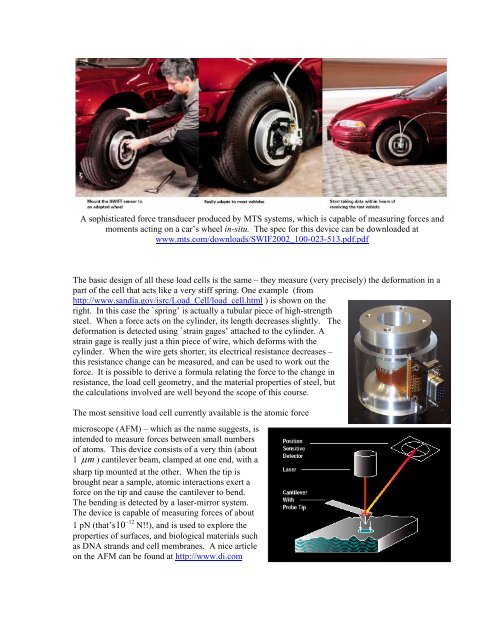Chapter 2 Review of Forces and Moments - Brown University
Chapter 2 Review of Forces and Moments - Brown University
Chapter 2 Review of Forces and Moments - Brown University
You also want an ePaper? Increase the reach of your titles
YUMPU automatically turns print PDFs into web optimized ePapers that Google loves.
A sophisticated force transducer produced by MTS systems, which is capable <strong>of</strong> measuring forces <strong>and</strong><br />
moments acting on a car’s wheel in-situ. The spec for this device can be downloaded at<br />
www.mts.com/downloads/SWIF2002_100-023-513.pdf.pdf<br />
The basic design <strong>of</strong> all these load cells is the same – they measure (very precisely) the deformation in a<br />
part <strong>of</strong> the cell that acts like a very stiff spring. One example (from<br />
http://www.s<strong>and</strong>ia.gov/isrc/Load_Cell/load_cell.html ) is shown on the<br />
right. In this case the `spring’ is actually a tubular piece <strong>of</strong> high-strength<br />
steel. When a force acts on the cylinder, its length decreases slightly. The<br />
deformation is detected using `strain gages’ attached to the cylinder. A<br />
strain gage is really just a thin piece <strong>of</strong> wire, which deforms with the<br />
cylinder. When the wire gets shorter, its electrical resistance decreases –<br />
this resistance change can be measured, <strong>and</strong> can be used to work out the<br />
force. It is possible to derive a formula relating the force to the change in<br />
resistance, the load cell geometry, <strong>and</strong> the material properties <strong>of</strong> steel, but<br />
the calculations involved are well beyond the scope <strong>of</strong> this course.<br />
The most sensitive load cell currently available is the atomic force<br />
microscope (AFM) – which as the name suggests, is<br />
intended to measure forces between small numbers<br />
<strong>of</strong> atoms. This device consists <strong>of</strong> a very thin (about<br />
1 μ m ) cantilever beam, clamped at one end, with a<br />
sharp tip mounted at the other. When the tip is<br />
brought near a sample, atomic interactions exert a<br />
force on the tip <strong>and</strong> cause the cantilever to bend.<br />
The bending is detected by a laser-mirror system.<br />
The device is capable <strong>of</strong> measuring forces <strong>of</strong> about<br />
12<br />
1 pN (that’s10 − N!!), <strong>and</strong> is used to explore the<br />
properties <strong>of</strong> surfaces, <strong>and</strong> biological materials such<br />
as DNA str<strong>and</strong>s <strong>and</strong> cell membranes. A nice article<br />
on the AFM can be found at http://www.di.com
















